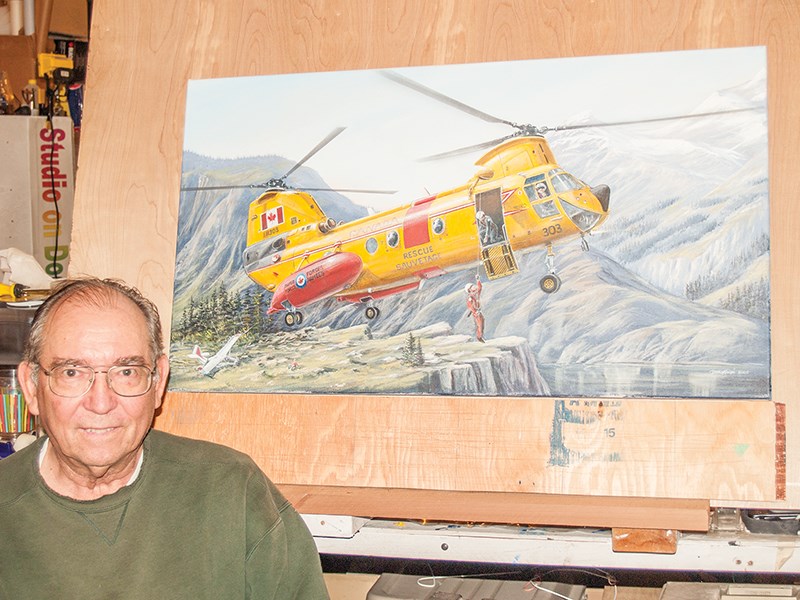Leading up to the 100th anniversary of Canada’s victory at Vimy Ridge in France during World War I (WWI), a local Canadian artist is busy planning an important commemorative work.
Texada resident O.C. (Doby) Dobrostanski is creating a painting that captures the essence of courageous aviators who flew above ground troops at Vimy Ridge. Four Canadian divisions, numbering 100,000 troops, attacked the Germans together as a unified front for the first time.
While most Canadian soldiers fought fearsome ground battles in trenches and muddy fields, some took to the skies. Canadian general Arthur Currie learned of aerial photo scouting from the French and applied this tactic to help Canadians discover German positions in advance of the Vimy battle.
Of the 66,000 Canadians killed during WWI, almost 3,600 were killed at Vimy Ridge in April of 1917; more than 7,000 more were wounded.
Aerial intelligence was key to the Canadian offensive that forced the Germans to retreat. To mark this important achievement, France donated 250 acres of land to Canada to build and maintain the Canadian National Vimy Memorial, which was completed in 1936.
As Remembrance Day approaches, Dobrostanski is busy researching ideas for his painting. The main feature will be the Sopwith Pup aircraft that flew over Vimy Ridge.
Dobrostanski is reading about WWI battles, examining aircraft insignias, and recently visited the Canadian Museum of Flight, where a replica of the Sopwith Pup is being built to 87.5 percent of the original size from scratch. The project is part of larger plans for the Vimy 2017 commemoration activities being scheduled in France and across Canada.
Dobrostanski has set a personal deadline for finishing the painting by February 15.
“I want to make the painting of this plane and WWI battle at Vimy as historically accurate as I can,” said Dobrostanski. “Though I’m not exclusively an aviation artist, of the approximately 50 planes I’ve painted so far, I consider this project to be the apex of my career. I’m very excited about it.”
Working from his visual-art studio, Dobrostanski will set the scene for his Vimy painting about 50 feet above the battlefield, as some of the “dogfighting” actually took place that low to the ground.
Canadian WWI ace Joe Fall, from Cobble Hill, BC, will be depicted flying a Sopwith, which had the names of his sisters Betty and Phyllis painted on it.
Fall, who shot down 36 enemy aircraft and two observation balloons in just five months, is the only pilot in history to receive, from Buckingham Palace, the Distinguished Service Cross with two bars for gallantry in the air.
Another Canadian pilot will be depicted flying nearby in a Nieuport 17 C-1. Together the pilots will face down a German Fokker fighter plane. Below, Canadian soldiers will be depicted fighting against the Germans. In the background, viewers will see a ghostly shadow of the future Vimy Memorial. The finished painting will first be exhibited at the Canadian Museum of Flight.
Dobrostanski is well known in the aviation community and a member of the Canadian Aerospace Artists Association, which celebrates Canada’s aviation heritage through art. During his 16 years in the Royal Canadian Air Force, Dobrostanski worked as an aero-engine technician and instructor at 435 Squadron in Edmonton on the Beechcraft C-45 Expeditor, Canadair C-114 Tutor, Douglas C-47 Dakota, Grumman SA-16 Albatross, Lockheed T-33 jet trainer and Lockheed C-130 Hercules.
Locally, Dobrostanski is president of the Texada Island Aviation Society and Texada Aerospace Camp, which will be expanded this year to include a new two-day Texada Aviation Arts Camp. He also oversees the Texada Annual Fly-In, which welcomed more than 70 planes last year and regularly features some outstanding formation flying demonstrations by crowd favourite Fraser Blues.
Dobrostanski has also taken to the skies himself. In the past he was a glider pilot. One of his most memorable experiences in the sky was achieving a flight time of five hours and seven minutes, which takes a lot of skill, and the bladder of a camel.
When Dobrostanski talks about what he loves most about flight, he provides a glimpse of a man who favours the mind over emotion and technical skills over drama and dreaming.
“Flying is a challenge intellectually, physically and technically,” he said. “It’s the ability to master motion, the limits of the individual and the technical design of the aircraft, whether powered or a glider. Flying is beyond transportation, it’s a total intellectual immersion where the pilot has to understand physics, engineering and meteorology.”
Beyond this, Dobrostanski also believes that flying is “a very beautiful aesthetic,” which is perhaps where the paint brush comes in.
As a member of Royal Canadian Legion Branch 232 on Texada, Dobrostanski interacts regularly with fellow men and women who served in the military. He has seen firsthand how veterans are not always fully supported by our government upon their return, which is why he promotes all efforts of the legion to acquire new members. His view is to raise funds and broaden community support to provide our veterans a better quality of life.
Dobrostanski said that his commemorative Vimy painting will not be a glorification of war, but is intended to invite Canadians to think seriously about the conditions upon which our country enters into war and of the often devastating consequences on soldiers and civilians, whether domestic or international.



